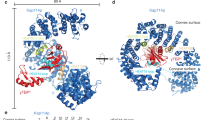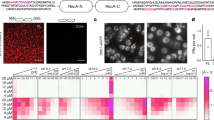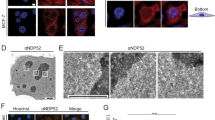Abstract
Regulation of nuclear mRNA export is critical for proper eukaryotic gene expression. A key step in this process is the directional translocation of mRNA–ribonucleoprotein particles (mRNPs) through nuclear pore complexes (NPCs) that are embedded in the nuclear envelope1. Our previous studies in Saccharomyces cerevisiae defined an in vivo role for inositol hexakisphosphate (InsP6) and NPC-associated Gle1 in mRNA export2. Here, we show that Gle1 and InsP6 act together to stimulate the RNA-dependent ATPase activity of the essential DEAD-box protein Dbp5. Overexpression of DBP5 specifically suppressed mRNA export and growth defects of an ipk1 nup42 mutant defective in InsP6 production and Gle1 localization. In vitro kinetic analysis showed that InsP6 significantly increased Dbp5 ATPase activity in a Gle1-dependent manner and lowered the effective RNA concentration for half-maximal ATPase activity. Gle1 alone had minimal effects. Maximal InsP6 binding required both Dbp5 and Gle1. It has been suggested that Dbp5 requires unidentified cofactors3,4. We now propose that Dbp5 activation at NPCs requires Gle1 and InsP6. This would facilitate spatial control of the remodelling of mRNP protein composition during directional transport and provide energy to power transport cycles.
This is a preview of subscription content, access via your institution
Access options
Subscribe to this journal
Receive 12 print issues and online access
$209.00 per year
only $17.42 per issue
Buy this article
- Purchase on Springer Link
- Instant access to full article PDF
Prices may be subject to local taxes which are calculated during checkout




Similar content being viewed by others
References
Moore, M. J. From birth to death: The complex lives of eukaryotic mRNAs. Science 309, 1514–1518 (2005).
York, J. D., Odom, A. R., Murphy, R., Ives, E. B. & Wente, S. R. A phospholipase C-dependent inositol polyphosphate kinase pathway required for efficient messenger RNA export. Science 285, 96–100 (1999).
Tseng, S. S. et al. Dbp5p, a cytosolic RNA helicase, is required for poly(A)+ RNA export. EMBO J. 17, 2651–2662 (1998).
Schmitt, C. et al. Dbp5, a DEAD-box protein required for mRNA export, is recruited to the cytoplasmic fibrils of nuclear pore complex via a conserved interaction with CAN–Nup159p. EMBO J. 18, 4332–4347 (1999).
Pemberton, L. F. & Paschal, B. M. Mechanisms of receptor-mediated nuclear import and nuclear export. Traffic 6, 187–198 (2005).
Rodriguez, M. S., Dargemont, C. & Stutz, F. Nuclear export of RNA. Biol. Cell 96, 639–655 (2004).
Rocak, S. & Linder, P. DEAD-box proteins: the driving forces behind RNA metabolism. Nature Rev. Mol. Cell Biol. 5, 232–241 (2004).
Hodge, C. A., Colot, H. V., Stafford, P. & Cole, C. N. Rat8p–Dbp5p is a shuttling transport factor that interacts with Rat7p–Nup159p and Gle1p and suppresses the mRNA export defect of xpo1-1 cells. EMBO J. 18, 5778–5788 (1999).
Estruch, F. & Cole, C. N. An early function during transcription for the yeast mRNA export factor Dbp5p–Rat8p suggested by its genetic and physical interactions with transcription factor IIH components. Mol. Biol. Cell 14, 1664–1676 (2003).
Zhao, J., Jin, S. B., Bjorkroth, B., Wieslander, L. & Daneholt, B. The mRNA export factor Dbp5 is associated with Balbiani ring mRNP from gene to cytoplasm. EMBO J. 21, 1177–1187 (2002).
Weirich, C. S., Erzberger, J. P., Berger, J. M. & Weis, K. The N-terminal domain of Nup159 forms a β-propeller that functions in mRNA export by tethering the helicase Dbp5 to the nuclear pore. Mol. Cell 16, 749–760 (2004).
Murphy, R. & Wente, S. R. An RNA-export mediator with an essential nuclear export signal. Nature 383, 357–360 (1996).
Kendirgi, F., Barry, D. M., Griffis, E. R., Powers, M. A. & Wente, S. R. An essential role for hGle1 nucleocytoplasmic shuttling in mRNA export. J. Cell Biol. 160, 1029–1040 (2003).
Odom, A. R., Stahlberg, A., Wente, S. R. & York, J. D. A role for nuclear inositol 1,4,5-trisphosphate kinase in transcriptional control. Science 287, 2026–2029 (2000).
York, S. J., Armbruster, B. N., Greenwell, P., Petes, T. D. & York, J. D. Inositol diphosphate signaling regulates telomere length. J. Biol. Chem. 280, 4264–4269 (2005).
Steger, D. J., Haswell, E. S., Miller, A. L., Wente, S. R. & O'Shea, E. K. Regulation of chromatin remodeling by inositol polyphosphates. Science 299, 114–116 (2003).
Macbeth, M. R. et al. Inositol hexakisphosphate is bound in the ADAR2 core and required for RNA editing. Science 306, 1534–1539 (2005).
Miller, A. L., Suntharalingam, M., Johnson, S. L., Audhya, A., Emr, S. D. & Wente, S. R. Cytoplasmic inositol hexakisphosphate production is sufficient for mediating the Gle1 mRNA export pathway. J. Biol. Chem. 279, 51022–51032 (2004).
Strahm, Y. et al. The RNA export factor Gle1p is located on the cytoplasmic fibrils of the NPC and physically interacts with the FG-nucleoporin Rip1p, the DEAD-box protein Rat8p–Dbp5p and a new protein Ymr 255p. EMBO J. 18, 5761–5777 (1999).
Rollenhagen, C., Hodge, C. A. & Cole, C. N. The nuclear pore complex and the DEAD box protein Rat8p–Dbp5p have nonessential features which appear to facilitate mRNA export following heat shock. Mol. Cell Biol. 24, 4869–4879 (2004).
Tseng-Rogenski, S. S. et al. Functional conservation of Dhh1p, a cytoplasmic DExD–H-box protein present in large complexes. Nucleic Acids Res. 31, 4995–5002 (2003).
Strawn, L. A., Shen, T. & Wente, S. R. The GLFG regions of Nup116p and Nup100p serve as binding sites for both Kap95p and Mex67p at the nuclear pore complex. J. Biol. Chem. 276, 6445–6452 (2001).
Jankowsky, E., Gross, C. H., Shuman, S. & Pyle, A. M. Active disruption of an RNA-protein interaction by a DExH–D RNA helicase. Science 291, 121–125 (2001).
Fairman, M. E. et al. Protein displacement by DExH–D 'RNA helicases' without duplex unwinding. Science 304, 730–734 (2004).
Snay-Hodge, C. A., Colot, H. V., Goldstein, A. L. & Cole, C. N. Dbp5p–Rat8p is a yeast nuclear pore-associated DEAD-box protein essential for RNA export. EMBO J. 17, 2663–2676 (1998).
Lund, M. K. & Guthrie, C. The DEAD-box protein Dbp5p is required to dissociate Mex67p from exported mRNPs at the nuclear rim. Mol. Cell 20, 645–651 (2005).
Kendirgi, F., Rexer, D. J., Alcazar-Roman, A. R., Onishko, H. M. & Wente, S. R. Interaction between the shuttling mRNA export factor Gle1 and the nucleoporin hCG1: a conserved mechanism in the export of Hsp70 mRNA. Mol. Biol. Cell 16, 4304–4315 (2005).
Rayala, H. J., Kendirgi, F., Barry, D. M., Majerus, P. W. & Wente, S. R. The mRNA export factor human Gle1 interacts with the nuclear pore complex protein Nup155. Mol. Cell. Proteomics 3, 145–155 (2004).
Suntharalingam, M., Alcazar-Roman, A. R. & Wente, S. R. Nuclear export of the yeast mRNA-binding protein Nab2 is linked to a direct interaction with Gfd1 and to Gle1 function. J. Biol. Chem. 279, 35384–35391 (2004).
Shears, S. B. Assessing the omnipotence of inositol hexakisphosphate. Cell Signal. 13, 151–158 (2001).
Ives, E. B., Nichols, J., Wente, S. R. & York, J. D. Biochemical and functional characterization of inositol 1,3,4,5,6-pentakisphosphate 2-kinases. J. Biol. Chem. 275, 36575–36583 (2000).
Shears, S. B. in Signaling by Inositides: A Practical Approach (ed. Hames, B. D.) 134–135 (Oxford Univ. Press, Leeds, 1997).
Windgassen, M. et al. Yeast shuttling SR proteins Npl3p, Gbp2p, and Hrb1p are part of the translating mRNPs, and Npl3p can function as a translational repressor. Mol. Cell. Biol. 24, 10479–10491 (2004).
Acknowledgements
We thank C. Cole, J. York, R. Emeson and M. Fournier for plasmids, strains and reagents, and J. York and members of the Wente and Hardy labs for critical discussions and comments. This work was supported by a National Institutes of Health (NIH) grant (R01–GM51219) to S.R.W. and an National Research Service Award (NSRA) NIH Virus, Nucleic Acids and Cancer position (5T32–CA009385) and Ruth Kirschstein NIH NSRA (1F32–GM075459) to E.J.T.
Author information
Authors and Affiliations
Corresponding author
Ethics declarations
Competing interests
The authors declare no competing financial interests.
Supplementary information
Supplementary Information
Supplementary Methods and Supplementary Table S1 (PDF 186 kb)
Rights and permissions
About this article
Cite this article
Alcázar-Román, A., Tran, E., Guo, S. et al. Inositol hexakisphosphate and Gle1 activate the DEAD-box protein Dbp5 for nuclear mRNA export. Nat Cell Biol 8, 711–716 (2006). https://doi.org/10.1038/ncb1427
Received:
Accepted:
Published:
Issue Date:
DOI: https://doi.org/10.1038/ncb1427
This article is cited by
-
Cellular functions of eukaryotic RNA helicases and their links to human diseases
Nature Reviews Molecular Cell Biology (2023)
-
Emerging molecular functions and novel roles for the DEAD-box protein Dbp5/DDX19 in gene expression
Cellular and Molecular Life Sciences (2021)
-
The Hitchhiker’s Guide to Nucleocytoplasmic Trafficking in Neurodegeneration
Neurochemical Research (2020)
-
Structural and functional analysis of mRNA export regulation by the nuclear pore complex
Nature Communications (2018)
-
Control of mammalian gene expression by selective mRNA export
Nature Reviews Molecular Cell Biology (2015)



